Discover 20 hidden attractions, cool sights, and unusual things to do in Jena (Germany). Don't miss out on these must-see attractions: Phyletisches Museum, Jenzig, and Botanical Garden. Also, be sure to include Camsdorf Bridge in your itinerary.
Below, you can find the list of the most amazing places you should visit in Jena (Thuringia).
Table of Contents
Phyletisches Museum

Museum in Jena, Germany. Jena Phyletisches Museum is a museum in the German town of Jena. It was established by the scientist Ernst Haeckel, as an institute dedicated to explaining evolution to the public. Exhibits include skeletons, stuffed animals, fossils and zoological artworks from Haeckel's Kunstformen der Natur, and cover topics including the principles of evolution, biodiversity and the links between different taxonomic groups.
A temporary exhibit for 2019 will feature an aquarium of living jellyfish.[1]
Address: Vor dem Neutor 1, 07743 Jena
Jenzig
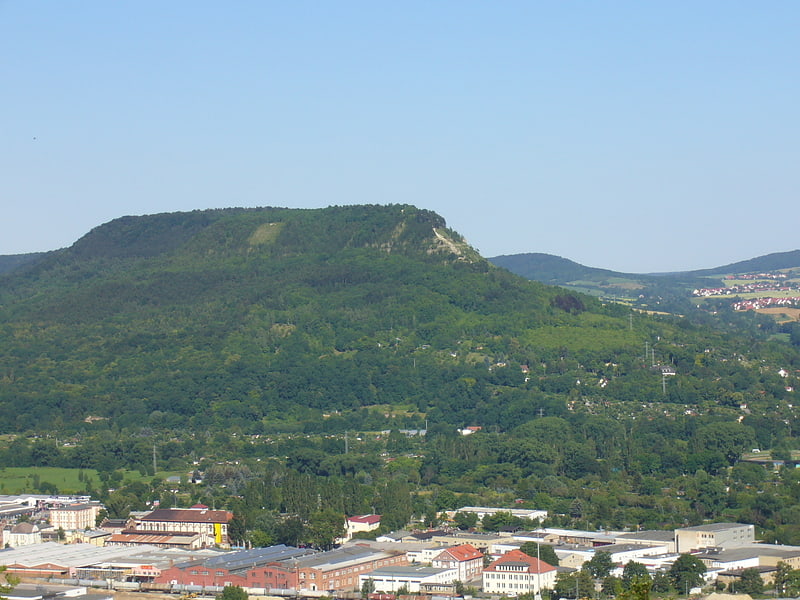
Mountain in Germany. The Jenzig is a distinctive Muschelkalk mountain in Jena, Germany.
At 385.3 m above sea level, the Jenzig is one of the highest mountains in the Saale Valley area and is located northeast of the city center. Due to its distinctive shape ("Jenzignase", German for "Jenzig nose") it is considered to be one of the Seven Wonders of Jena.
On the summit stands the Jenzighaus, a restaurant with excellent views over the city.
The Jenzig forms the southwestern end of a semicircular ridge, the Hufeisen ("Horseshoe"). This wooded plateau runs from the Jenzig eastwards, forming an arc as it continues further north and then back westwards, where the Alte Gleisberg along with the Kunitzburg forms the other end. In the interior of this "horseshoe" is a small side valley of the Saale valley, containing the villages of Kunitz and Laasan.[2]
Botanical Garden
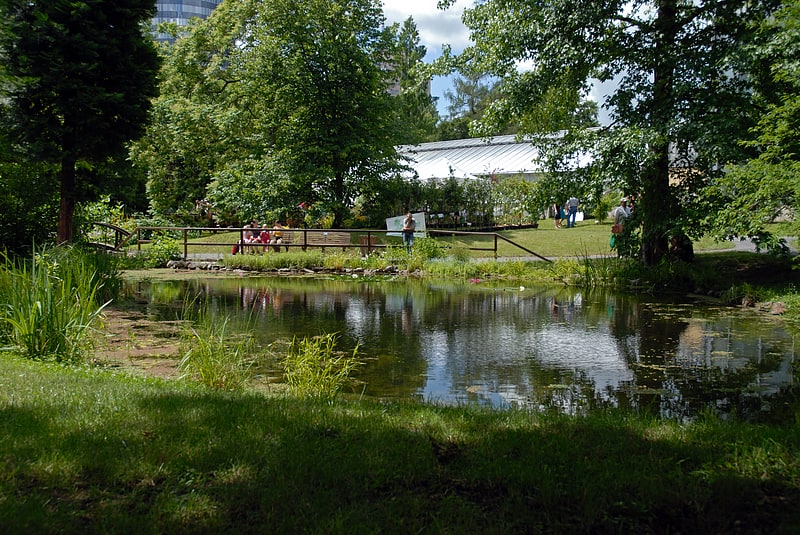
Also known as: Botanischer Garten
Botanical garden in Jena, Germany. The Botanischer Garten Jena is the second oldest botanical garden in Germany, maintained by the University of Jena and located at Fürstengraben 26, Jena, Thuringia, Germany. It is open daily; an admission fee is charged.
The garden was first established in 1586 as a hortus medicus, six years after the establishment of the Botanical Garden in Leipzig in 1580. In 1630 it was rearranged and expanded significantly by Professor Werner Rolfinck who had previously studied at the Orto botanico di Padova (founded 1545). In 1640 a second section (1.3 hectares in area, north of the city walls) was donated, and a catalog from 1659 documents over 1300 plants in the two gardens. In 1662 the original garden was expanded, with the first heated greenhouse added in 1674, at which time the garden first began to maintain a collection of tropical plants.
In 1770 the garden introduced Linnean taxonomy, and in 1776 Goethe began his association with the garden and helped organize the Jena Institute of botany; over subsequent decades he often studied botany and wrote poems in the garden. Although the garden area was only 1.3 hectares at this time, purchases recorded in 1794 include Buxus sempervirens, Juniperus sabina, Periploca graeca, Sambucus racemosa, and Thuja occidentalis. Several years later, additional purchases included amaryllis, cacti, succulent Euphorbia, Pelargonium, and Zantedeschia. The garden's first published catalog issued in 1795.
Unfortunately, the garden was severely damaged in 1806 in the Napoleonic Battle of Jena-Auerstedt, and its recovery was long and slow. By 1819 the garden contained only some 50 potted plants in one greenhouse and approximately 200 outdoor plants. However, in 1820 an additional greenhouse was constructed, and the existing greenhouses reorganized to become an orangery, palm house, and cold house. The garden was thoroughly reworked between 1877 and 1879, after which it contained 2020 species from 85 families as well as a medicinal garden and 13 groups of potted plants from geographically distinct regions. As of 1966 this number had grown substantially to about 2000 families, to which were added a further 300 families (more than 3000 species) in a new alpine plant collection.
Today the garden contains about 12,000 plants. Its outdoor areas include an arboretum containing about 900 species of deciduous and coniferous trees and shrubs; an alpine garden representing approximately 2,500 species; a systematic garden organized by contemporary taxonomy; a collection of medicinal and useful plants; a small hill and pond; and a collection of rhododendrons, roses, and dahlias. Its five greenhouses are as follows: cactus and succulent house; cold house for the transitional zone between tropics and subtropics; palm and tropical house; "evolution" house with ancient plant forms including cycads and tree ferns; and a tropical aquatic house which contains Victoria cruziana, mangroves, epiphytes, etc.[3]
Address: Fuerstengraben 26, 07743 Jena
Camsdorf Bridge
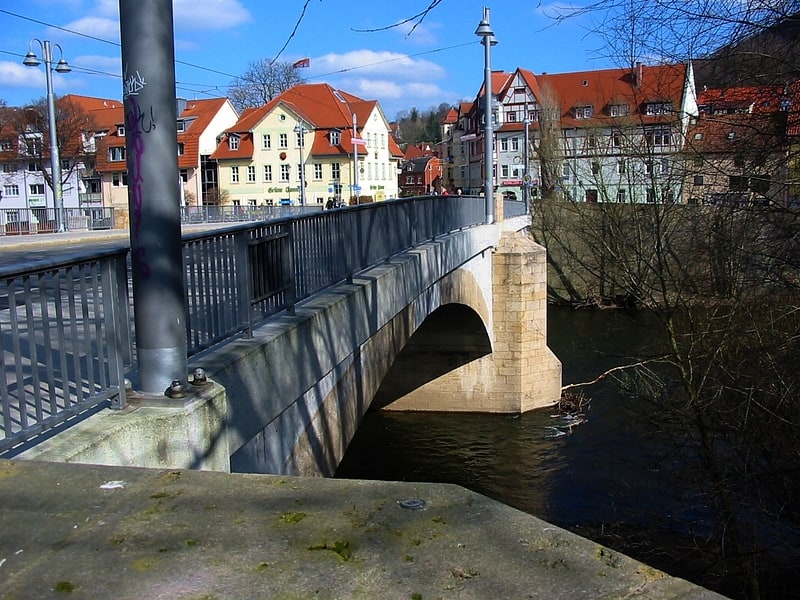
Also known as: Camsdorfer Brücke
Bridge in Jena, Germany. The Camsdorf Bridge is a bridge over the Saale river in Jena, Germany. It connects the city center of Jena with the suburb of Wenigenjena and is considered to be the oldest stone arch bridge in Jena.[4]
Address: Wenigenjenaer Ufer, Jena
Johannistor

Historical landmark in Jena, Germany. The Johannistor is the only remaining preserved city gate of the city of Jena, Thuringia, Germany. As part of the medieval city wall, it is connected to the Pulverturm via a reconstructed walkway. The outer gate remained in existence until the beginning of the nineteenth century, when it was demolished as a result of increasing traffic. Until the houses lining the south side of Johannisstrasse were demolished in 1968, the Johannistor remained the only western entrance to the old town of Jena.[5]
Optisches Museum Jena
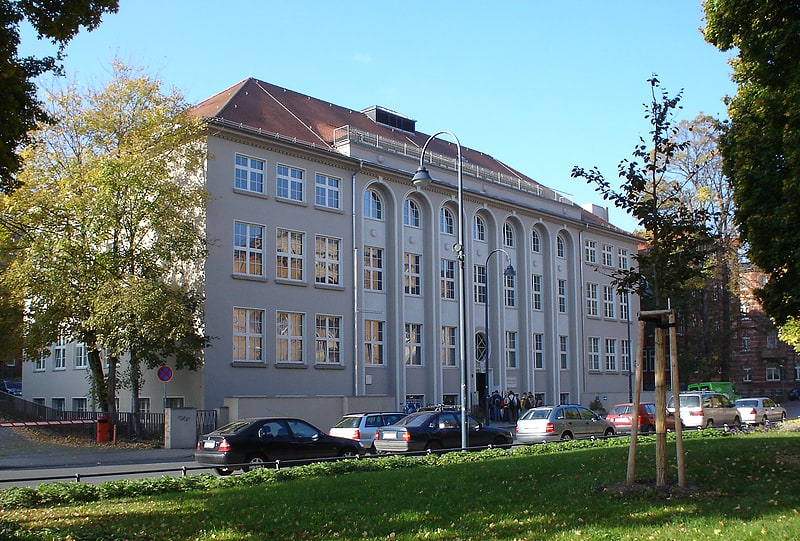
Also known as: Deutsches Optisches Museum
Museum in Jena, Germany. The Deutsches Optisches Museum Jena is a science and technology museum displaying optical instruments from eight centuries. It gives a technical and cultural-historical survey of the development of optical instruments. The development of the city Jena to the centre of the optical industries since the mid-19th-century is integrated in the exhibition, connected with the lifeworks of Ernst Abbe, Carl Zeiss and Otto Schott.
In cooperation with the art club Jena non-optical themes are offered in special exhibitions.
Before the opening of the Zeiss Museum of Optics in Oberkochen in 2014, the Deutsches Optisches Museum Jena was the only museum of its kind in Germany.[6]
Address: Carl-Zeiss-Platz 12, 07743 Jena
JenTower
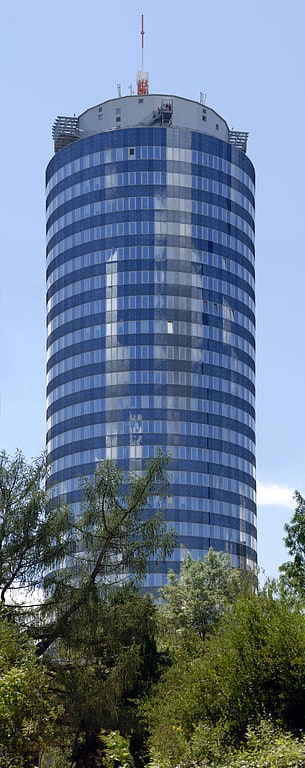
Also known as: Jentower
Skyscraper in Jena, Germany. The JenTower is a skyscraper in Jena, Germany.[7]
Address: Leutragraben 1, 07743 Jena
Planetarium Jena
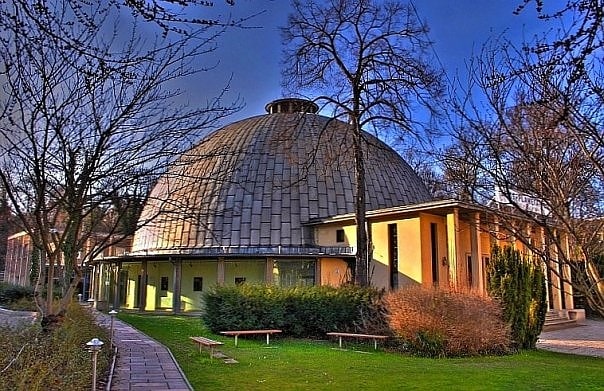
Domed edifice for high-tech star-gazing. The Zeiss-Planetarium in Jena, Germany is the oldest continuously operating planetarium in the world. It was opened on July 18, 1926. The Zeiss-Planetarium is a projection planetarium. The planets and fixed stars are projected onto the inner surface of a white cupola.
The Zeiss-Planetarium is owned and operated by the Ernst-Abbe-Stiftung.
It was engineered by German engineer Walther Bauersfeld.[8]
Address: Am Planetarium 5, 07743 Jena
Jena Observatory
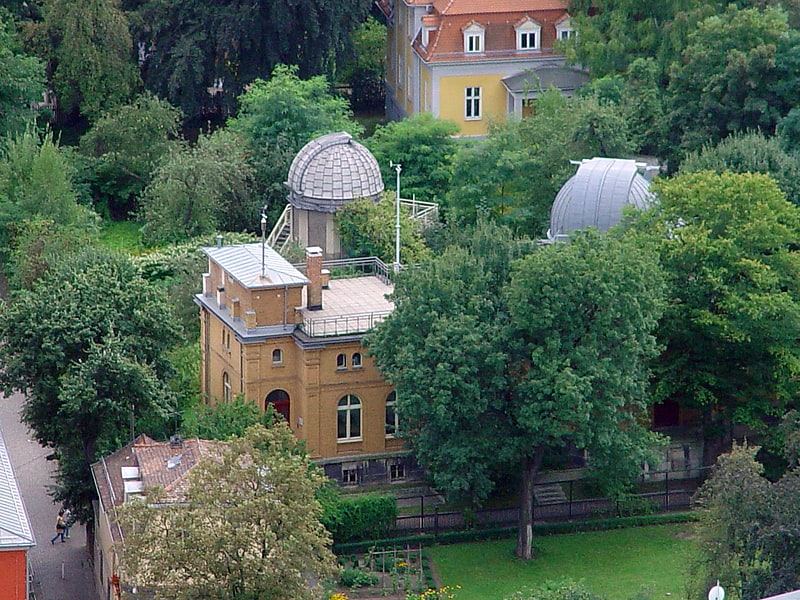
Also known as: Astrophysikalisches Institut und Universitäts-Sternwarte Jena
Astronomical observatory. Astrophysikalisches Institut und Universitäts-Sternwarte Jena is an astronomical observatory owned and operated by Friedrich Schiller University of Jena. It is located in Großschwabhausen close to Jena, Germany.[9]
Address: 2-3 Schillergäßchen, Jena
Romantikerhaus

The Romantics' House Literature Museum is located in the former home of philosophers Johann Gottlieb Fichte and Jakob Hermann Obereit in Jena.
The permanent exhibition on Jena's early Romanticism shows the cultural and intellectual historical background for the awakening of a young generation of poets, literary critics, philosophers and natural scientists. It illuminates the conditions under which Jena succeeded in developing into Germany's most progressive intellectual center between 1785 and 1803.
The intellectual and cultural charisma of Jena embodies an essential creative prerequisite of the early Romantic period. Based on the publishing activities in Jena, the importance of Carl Friedrich Ernst Fromman, his circle of friends and the literary conditions around 1800, the foundation of the "Athenaeum" as a program magazine of the early Romantic period is presented. A reenacted salon is dedicated to Romantic society.
An experimental cabinet of the physicist Johann Wilhelm Ritter shows the scientific commitment of the early Romantics and the complexity of Romantic thinking between nature research, social criticism and visions of the future. The Salon is dedicated to Romantic society. Part of the second floor is used for temporary exhibitions dealing with special topics related to Romanticism. A theater stage offers a variety of possibilities. The history of the European impact of Romanticism is shown both through the temporary exhibitions and through events.
Since 2005, the museum has been part of the JenaKultur municipal enterprise for culture, tourism and marketing.
Address: Unterm Markt 12A, 07743 Jena
Beutenberg Campus
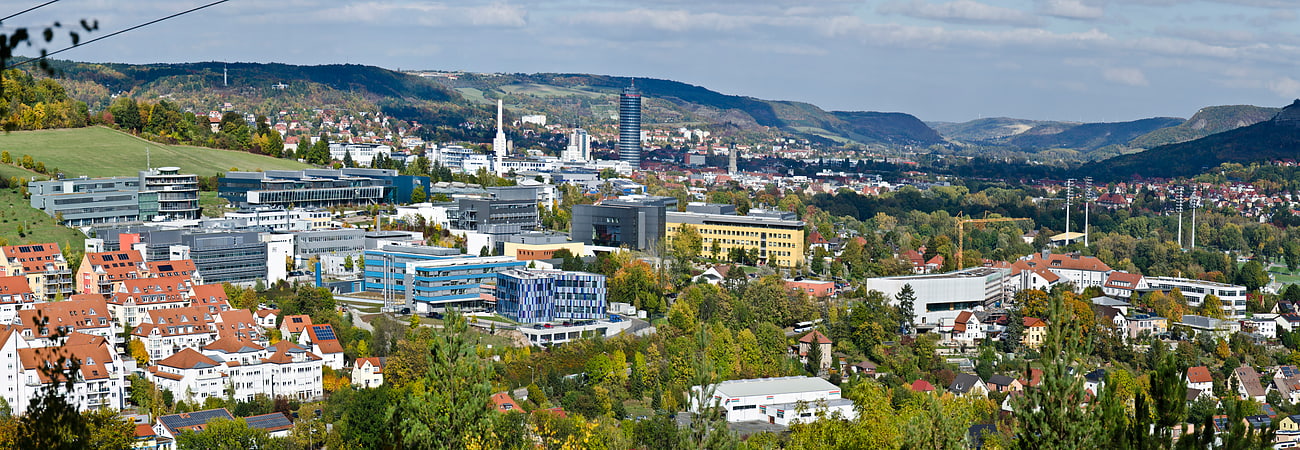
Residential college in Jena, Germany. The Beutenberg Campus is a science and research site situated in southern Jena, Germany. The physician Hans Knöll founded the first biomedical research institute at Beutenberg in 1950. From 1970, it was run as the Central Institute of Microbiology and Experimental Therapy of the Academy of Sciences of the GDR. From 1982 institutes focussing on physics were also set up on the site. Following German reunification in 1990, a multidisciplinary science and research centre was created in response to a recommendation by the German Council of Science and Humanities.
The campus currently hosts nine research institutes. These include three Leibniz Association institutes, two Max Planck Society institutes, one Fraunhofer Society institute, one institute funded by the State of Thuringia, as well as Friedrich Schiller University institutes. Two start-up centres, the Technology and Innovation Park Jena and the Bioinstrumentation centre, host more than 50 companies. In addition, Wacker Biotech GmbH has established biotechnology production facilities on campus.
Beutenberg Campus offers an interdisciplinary knowledge and technology platform for work in innovative research. It is a competence centre for research in terms of the guidelines Life Science meets Physics. The areas of biology, natural product chemistry, environmental research and medicine complement the physics of optics, photonics and optical microsystems.
Over 2300 people currently work on the Campus, more than 1000 are scientists. German and foreign students pursue their PhDs in association with one of the seven international research schools and in close cooperation with the Friedrich Schiller University of Jena.[10]
Address: 11 Beutenbergstraße, Jena
Volkshaus
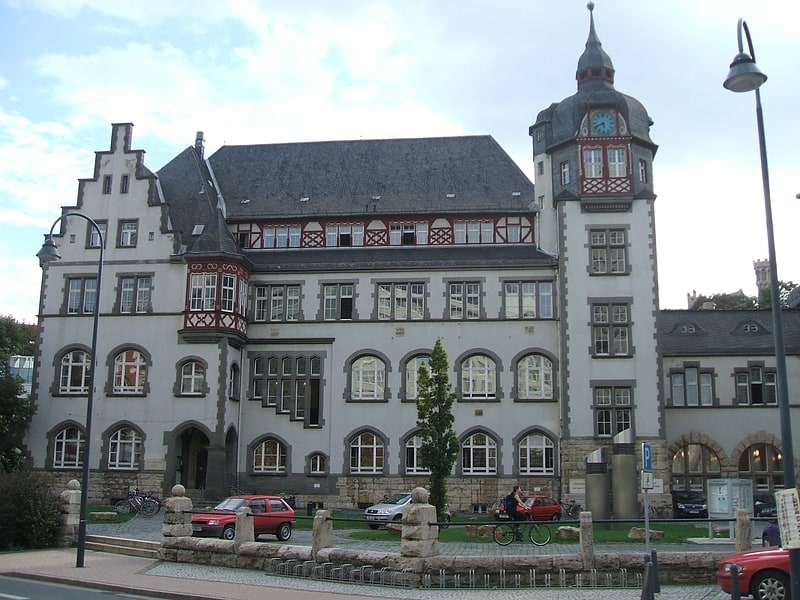
Event venue in Jena, Germany. The Volkshaus in Jena was one of the first free educational institutions in Germany to be set up on the North American model.[11]
Address: Carl-Zeiss-Platz 15, Jena
Theaterhaus Jena
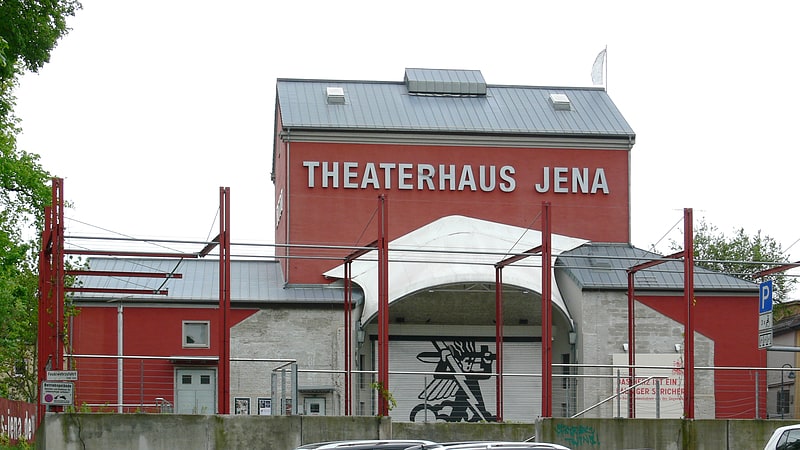
The Theaterhaus Jena is the theater of the city of Jena.
Address: Schillergaesschen 1, 07745 Jena
University of Jena

Also known as: Friedrich-Schiller-Universität Jena
Public university in Jena, Germany. The University of Jena, officially the Friedrich Schiller University Jena, is a public research university located in Jena, Thuringia, Germany.
The university was established in 1558 and is counted among the ten oldest universities in Germany. It is affiliated with six Nobel Prize winners, most recently in 2000 when Jena graduate Herbert Kroemer won the Nobel Prize for physics. It was renamed after the poet Friedrich Schiller who was teaching as professor of philosophy when Jena attracted some of the most influential minds at the turn of the 19th century. With Karl Leonhard Reinhold, Johann Gottlieb Fichte, G. W. F. Hegel, F. W. J. Schelling and Friedrich Schlegel on its teaching staff, the university was at the centre of the emergence of German idealism and early Romanticism.
As of 2014, the university has around 19,000 students enrolled and 375 professors. Its current president, Walter Rosenthal, was elected in 2014 for a six-year term.[12]
Address: Schillergäßchen 2, Jena
Volkssternwarte Urania
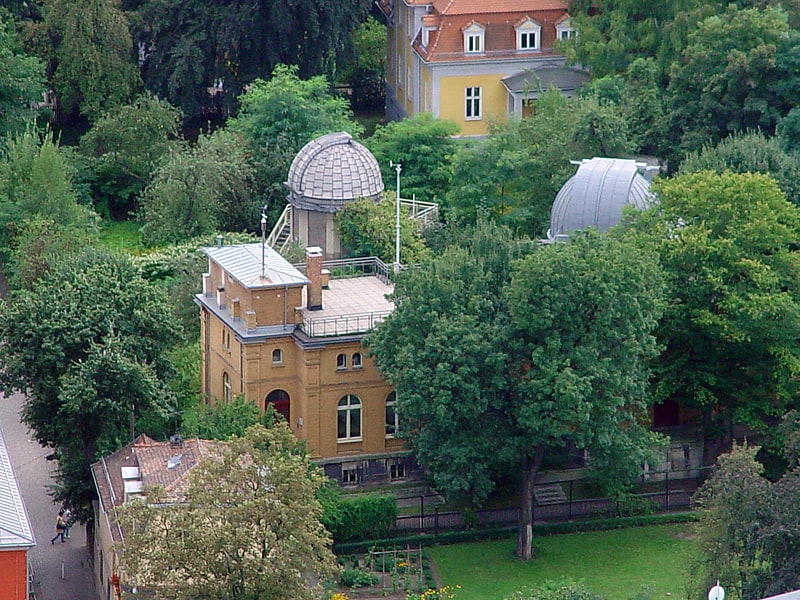
The Volkssternwarte Urania Jena is an observatory operated by a non-profit association of the same name as a successor to the Zeiss observatory. It is located in Schillergäßchen in the center of the city of Jena.
The association operates another observatory, the Forststernwarte, which was temporarily under the control of the University of Jena. This is located three kilometers from Jena and at an altitude of 345 m above sea level.
Address: Schillergäßchen 1, 07745 Jena
Kulturarena

The Theaterhaus Jena is the theater of the city of Jena.
Volksbad

Concert hall, Night club
Address: Knebelstr. 10, 07743 Jena
Ernst-Abbe-Denkmal

The Ernst Abbe Monument is a memorial hall for the physics professor and social reformer Ernst Abbe in Jena, Germany.
Red Tower

Also known as: Roter Turm
The Red Tower is a part of the old city wall of Jena.
Around 1300, Jena's city fortifications had reached the point where one could speak of a closed complex. It consisted of ditches, walls, kennel areas, three gate towers, four corner bastions and twelve shell towers added later. The Red Tower, a shell tower at the southeast corner of the city wall, was converted into an open gun bastion with embrasures and gun chambers around 1430 as part of extensive construction work on the fortifications. During archaeological excavations in 1995, finds from the pre-urban settlement period in the 11th/12th century and isolated pieces dating back to the Bronze Age were recovered.
In more recent times, only the base is preserved in its former state. In 1870, the natural stone base was covered with red exposed brickwork. The result was a four-story masonry building for residential purposes with wooden beam ceilings and interior half-timbered walls. The tower, about 19 meters high, is founded about 3 meters below ground level and has a diameter of slightly more than twelve meters.
On August 7, 1995, the tower structure collapsed due to failure of the exterior masonry during renovation work. Four construction workers were killed and four others injured in this accident. The 51 cm thick outer masonry on the I upper floor consisted of a thin outer shell of brick and an inner shell of soft lime tuff. In order to replace the damaged cornice running around under the windows, this had been broken out in several places at the same time, so that the weight of the upper stories in these areas could predominantly only have been borne by the inner masonry shell. This apparently did not have sufficient load-bearing capacity and gave way.
In 1999-2000, the tower was rebuilt in its historical appearance at a cost of 1.3 million euros.
For a while, the Red Tower housed, among other things, the exhibition rooms of the Jena Art Association.
In 2021, the premises housed a law firm and a digital agency.
Address: 11a Löbdergraben, Jena
Anatomieturm
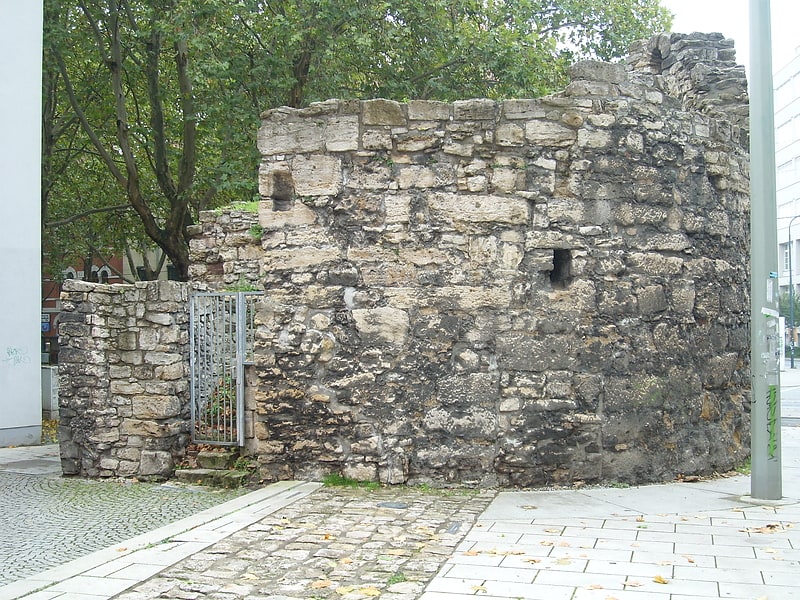
Anatomieturm stands for the following towers: Anatomieturm (Jena), ruinous round tower and part of the remains of the city wall of Jena, Anatomieturm (Regensburg), city wall tower of Regensburg